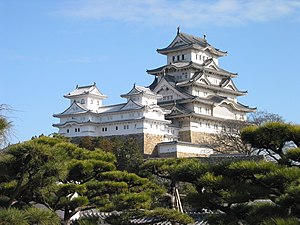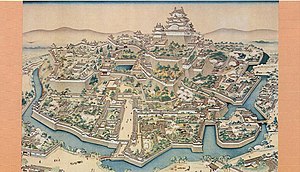Himeji Castle
From Wikipedia, the free encyclopedia
| Himeji Castle 姫路城 |
|
|---|---|
| Himeji, Hyogo Prefecture, Japan | |
 View from Nishi-no-maru |
|
| Type | Azuchi-Momoyama castle |
| Built | 1333-1346; major expansions 1601-1608 |
| Built by | Akamatsu clan (original); Toyotomi Hideyoshi (1580) Ikeda Terumasa (17th c. expansion) |
| Construction materials |
Wood, stone, plaster, tile |
| In use | 1333-1868 |
| Demolished | 1580, and rebuilt by Toyotomi Hideyoshi |
| Current condition |
Largely intact, restoration work begun in 1956 |
| Controlled by | Akamatsu clan (1346-1580), Toyotomi Hideyoshi (1580-1598), Tokugawa shogunate (1603-1871), Japan (1871-present) |
| Commanders | Kuroda Yoshitaka (c. 1580-1590s), Ikeda Terumasa (c. 1601-1610s) |
Himeji Castle (姫路城 Himeji-jō) is a flatland-mountain Japanese castle complex located in Himeji in Hyōgo Prefecture and comprising 83 wooden buildings. It is occasionally known as Hakurojō or Shirasagijō ("White Heron Castle") because of its brilliant white exterior.
It was registered as the first Japanese National Cultural Treasure by UNESCO World Heritage Site and a Japanese National Cultural Treasure in December, 1993. Along with Matsumoto Castle and Kumamoto Castle, it is one of Japan's "Three Famous Castles", and is the most visited castle in Japan.
Contents |
[edit] Architecture, defenses, and design
Himeji serves as an excellent example of the prototypical Japanese castle, containing many of the defensive and architectural features most associated with Japanese castles. The tall stone foundations, whitewash walls, and organization of the buildings within the complex are standard elements of any Japanese castle, and the site also features many other examples of typical castle design, including gun emplacements and stone-dropping holes.
One of Himeji's most important defensive elements, and perhaps its most famous, is the confusing maze of paths leading to the main keep. The gates, baileys, and outer walls of the complex are organized so as to cause an approaching force to travel in a spiral pattern around the castle on their way into the keep, facing many dead ends. This allowed the intruders to be watched and fired upon from the keep during their entire approach. However, Himeji was never attacked in this manner, and so the system remains untested.
Himeji Castle was built in ?. At this time, it was called Himeyama Castle. In 1331, Akamatsu Sadanori planned a castle at the base of Mount Himeji, where Akamatsu Norimura had constructed the temple of Shomyoji. After Akamatsu fell during the Kakitsu War, Yamana clan briefly took over planning of the castle; the Akamatsu family took over again following the Ōnin War.
In 1580, Toyotomi Hideyoshi took control of the badly damaged castle, and Kuroda Yoshitaka built a three-story tower. Following the Battle of Sekigahara in 1600, Tokugawa Ieyasu granted Himeji Castle to Ikeda Terumasa who embarked on a nine-year expansion project that brought the castle roughly to its current form. "Only the east gate of one section of the second bailey" survive from the earlier period.[1] The current keep dates from 1601, and the last major addition, the Western Circle, was completed in 1618.
Himeji was one of the last holdouts of the tozama daimyō at the end of the Edo period. It was held by the descendants of Sakai Tadasumi until the Meiji Restoration. In 1868, the new Japanese government sent the Okayama army, under the command of a descendant of Ikeda Terumasa, to shell the castle with blank cartridges and drive its occupiers out.
When the han system was abolished in 1871, Himeji Castle was sold at auction. Its final price was 23 yen (in those days) and in public funds. Himeji was bombed twice in 1945, at the end of World War II. Although most of the surrounding area was burned to the ground, the castle survived almost entirely unscathed. Castle restoration efforts began in 1956.
[edit] Popular culture
Himeji Castle frequently appears on Japanese tv. Edo Castle (the present Tokyo) does not have a keep, so when a fictional show such as Abarenbo Shogun needs a magnificent substitute, the producers turn to Himeji.
[edit] In film
- In the James Bond film You Only Live Twice (1967), Himeji Castle appears as Tiger Tanaka's secret ninja training school and rocket weapons development centre.
- Himeji appears in Akira Kurosawa's Kagemusha (1980) and Ran (1985).
- The Last Samurai (2003), starring Tom Cruise, was shot on location at Himeji using artificial snow.
- In Shogun, a 1980 TV miniseries starring Richard Chamberlain, Himeji appears as Osaka Castle.
[edit] In videogames
- In Civilization Revolution for the Xbox 360, Playstation 3 and Nintendo DS, the Himeji Castle can be built as a Wonder.
[edit] Gallery: Castle in perspective
Panorama overview
View from the donjon
Looking up towards donjon
Walls
Non-photographic images
[edit] Literature
- Schmorleitz, Morton S. (1974). Castles in Japan. Tokyo: Charles E. Tuttle Co.. pp. 123–125. ISBN 0-8084-1102-4.
- Motoo, Hinago (1986). Japanese Castles. Tokyo: Kodansha. pp. 200 pages. ISBN 0-87011-766-1.
[edit] See also
- Koko-en Garden : a garden created in 1992 next to Himeji Castle
[edit] External links
| Wikimedia Commons has media related to: Himeji castle |
- Pictures of Himeji Castle and over 100 other Japanese Castles
- Himeji Castle Guide
- Himeji castle website (requires Macromedia Flash plugin)
- Official UNESCO page for Himeji castle
- Himeji Castle - Location View Himeji edition (Tourist Guide with 360degree movie map)
|
|||||||














